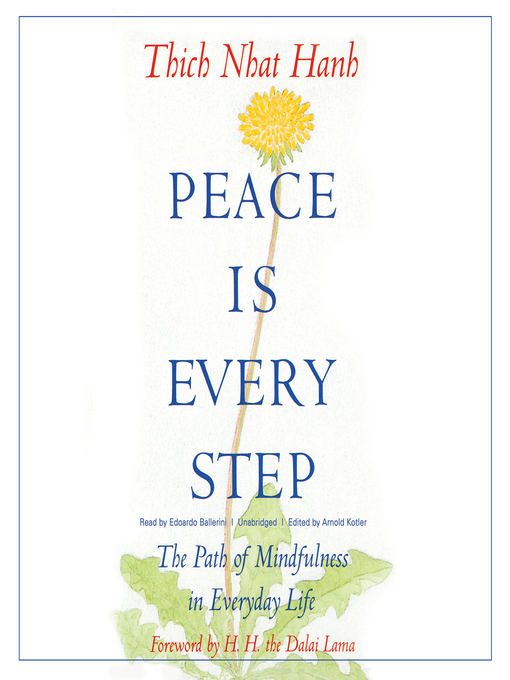Mindful Reading with Thich Nhat Hanh
by Alex Henton, Library Assistant

Since this month’s theme for ReadMHK is exploring beliefs, I decided to write about an author who is personally important to me and has helped heal people all over the world, for nearly a century: Thich Nhat Hanh.
Zen Master Thich Nhat Hanh (known by his students as “Thay,” meaning “teacher” in Vietnamese) was born in Vietnam in 1926 and ordained as a monk at the age of 16, when he chose to dedicate his life to reducing the suffering of all living beings, a Buddhist principle. He did so in many inspiring ways, such as practicing non-violence and neutrality in the midst of war-ridden polarization in Vietnam, as well as later establishing several monasteries throughout the world during a 39-year exile from his home country.
Here at Manhattan Public Library, we have 20 physical books written by Thich Nhat Hanh and several more available on Hoopla and the Sunflower eLibrary. Altogether, he published over 100 books throughout his life. Although Thay recently passed away in January 2022, his spirit continues to live with us through his stories.
The first book I ever read by Thay is called “Peace Is Every Step: The Path of Mindfulness in Everyday Life.” This book is such a breath of fresh air—and not just metaphorically. Thich Nhat Hanh’s teachings are centered around the practice of mindful breathing, and he writes with words that generate real peace within our minds and bodies. Like many of his books, this one transcends religious boundaries and emphasizes taking your daily practices seriously, regardless of your religious traditions or whether you even consider yourself spiritual at all. I came across this book during a really difficult time in my life, but I am so glad that I did, because I’ve been on a path of healing ever since. Thank you, Thay.
Another great introduction to Thich Nhat Hanh and his teachings is “The Miracle of Mindfulness: An Introduction to the Practice of Meditation.” Although the book was originally published in 1975, Thay’s advice is timeless. He favors practicality over theory, offering meditation exercises that are actually helpful in everyday life.
Do you find it difficult to approach others or talk to people with whom you’re in conflict? Another book I recommend checking out is “The Art of Communicating.” Published in 2013, Thay recognizes that, ironically, it’s harder to communicate with others in today’s globalized society, and especially with those who have hurt us in some way. This book could be read in just a few hours, but if you’re like me, each page will have so many helpful tips that you might not want to read more than a few pages at a time.
Thich Nhat Hanh’s books are generally short and written with simple language, but if you want a super-quick read, see “How to Relax.” This pocket-sized book, with illustrations by Jason DeAntonis, will bring you back to the present moment, allowing you to deeply relax your body and mind. He also provides easy-to-follow meditation guides at the end of the book.
You might be surprised to know that Thich Nhat Hanh has also written some wonderful children’s books. “Where Is the Buddha?” illustrated by Nguyen Quang and Kim Lien, is about a young monk named Minh who comes to find out that the Buddha is not actually where he thought he was. When Minh asks his head monk, the response he receives is delightful. If you are interested in exploring Buddhism with your child, this is a great book to read with them.
Finally, one of my overall personal favorites is called “Living Buddha, Living Christ.” I highly recommend this book for Christians, especially if you have certain doubts about your faith. This book has certainly played a key role in my own understanding of the Gospels, as Thay references the Bible often. Also, learning about other religious traditions is extremely powerful. It not only allows you to see the beautiful similarities and differences between yourself and another, but it also strengthens your own faith. Although Thay is a Buddhist, it’s clear that he has a deep love for Christianity.
With this, I hope I’ve convinced you to pick up a book written by Thich Nhat Hanh, or at least participate in exploring beliefs with us here at Manhattan Public Library. These cold winter months are a great time to read, and I hope that the knowledge you receive will allow you to truly heal yourself, your family, your community, and the world.

